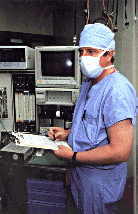Taking Care of Patients' Anesthetic and Critical Care Needs
 Dr. Thomas W. Feeley uses sophisticated support systems to ensure the best
anesthetic outcomes for cancer patients.
Dr. Thomas W. Feeley uses sophisticated support systems to ensure the best
anesthetic outcomes for cancer patients.Taking Care of Patients' Anesthetic and Critical Care Needs
 Dr. Thomas W. Feeley uses sophisticated support systems to ensure the best
anesthetic outcomes for cancer patients.
Dr. Thomas W. Feeley uses sophisticated support systems to ensure the best
anesthetic outcomes for cancer patients.
Return to Winter 98